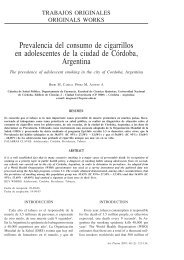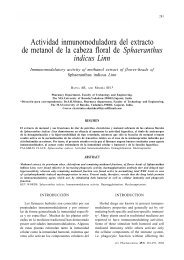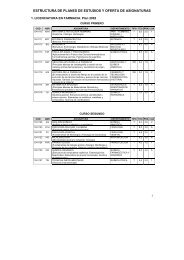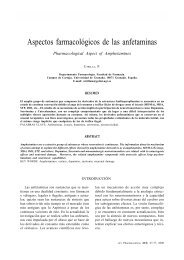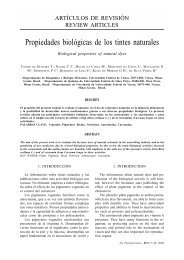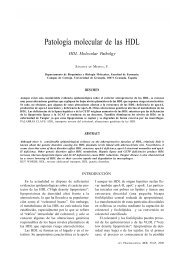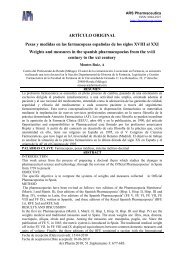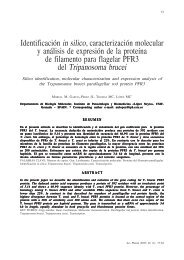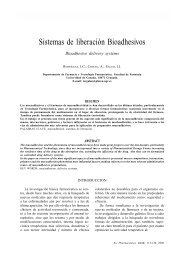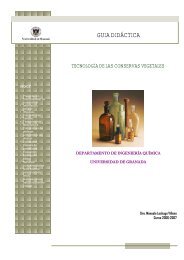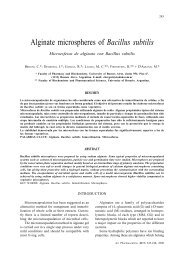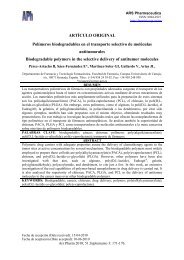p - Facultad de Farmacia - Universidad de Granada
p - Facultad de Farmacia - Universidad de Granada
p - Facultad de Farmacia - Universidad de Granada
Create successful ePaper yourself
Turn your PDF publications into a flip-book with our unique Google optimized e-Paper software.
ESTUDIO CINÉTICO DE LA FOTODEGRADACIÓN DEL IÓN P-HIDROXIBENCENODIAZONIO...<br />
KINETIC STUDY OF THE PHOTODEGRADATION OF P-HYDROXYBENZENEDIAZONIUM ION...<br />
Estudio cinético <strong>de</strong> la foto<strong>de</strong>gradación <strong>de</strong>l ión<br />
p-hidroxibencenodiazonio en medio polar<br />
Kinetic study of the photo<strong>de</strong>gradation of p-hydroxybenzenediazonium ion<br />
in polar media<br />
QUINTERO * B, CABEZA MC, MARTÍNEZ PUENTEDURA MI, MARTÍNEZ DE LAS PARRAS PJ, GUTIÉRREZ MP<br />
Depto. <strong>de</strong> Química Física, <strong>Facultad</strong> <strong>de</strong> <strong>Farmacia</strong>, <strong>Universidad</strong> <strong>de</strong> <strong>Granada</strong>, 18071 <strong>Granada</strong>, España.<br />
Este estudio está <strong>de</strong>dicado al Profesor J. Thomas Gómez con motivo <strong>de</strong> su jubilación<br />
*Autor <strong>de</strong> contacto: Tel.: +34-958-249071 fax: +34 958 244090<br />
Correo electrónico: bqosso@ugr.es<br />
RESUMEN<br />
Se ha realizado un estudio sobre la foto<strong>de</strong>scomposición <strong>de</strong>l ión p-hidroxibencenodiazonio (PDQ) basado en los datos<br />
espectrofotométricos y cromatográfi cos obtenidos con disoluciones <strong>de</strong> PDQ expuestas a irradiación UV (254 nm) en<br />
medio <strong>de</strong> acetonitrilo y agua. Los resultados <strong>de</strong> HPLC y HPLC-masa (HPLC/MS) indican que el 4-acetamidofenol<br />
es el principal producto que se forma tras la irradiación <strong>de</strong> PDQ en acetonitrilo. Esto se explica como consecuencia<br />
<strong>de</strong> la formación inicial <strong>de</strong>l catión arilo, que posteriormente participa en una reacción <strong>de</strong> Ritter. El análisis cinético<br />
<strong>de</strong> los datos espectrofotométricos revela que la foto<strong>de</strong>gradación <strong>de</strong> PDQ es más rápida en acetonitrilo (constante<br />
<strong>de</strong> velocidad observada, k obs , = 0,1442 s -1 ) que en acetonitrilo acidifi cado (k obs = 0,009 s -1 ), lo que indica una mayor<br />
fotoestabilidad <strong>de</strong> la especie protonada <strong>de</strong>rivada <strong>de</strong> PDQ. La constante <strong>de</strong> segundo or<strong>de</strong>n (0,062 M s -1 ) encontrada<br />
para la foto<strong>de</strong>scomposición <strong>de</strong> PDQ en tampón fosfato (pH 7) se justifi ca por el establecimiento <strong>de</strong> un equilibrio<br />
entre las especies protonada y no protonada proce<strong>de</strong>ntes <strong>de</strong> la disociación ácida <strong>de</strong> PDQ.<br />
PALABRAS CLAVE: p-hidroxibencenodiazonio. Foto<strong>de</strong>scomposición. Catión arilo. Análisis cinético.<br />
ABSTRACT<br />
A study on the photo<strong>de</strong>composition of p-hydroxybenzenediazonium ion (PDQ) has been ma<strong>de</strong> using chromatographic<br />
and spectrophotometric data obtained from UV-irradiated (254 nm) PDQ solutions in acetonitrile and aqueous media.<br />
The HPLC and HPLC-mass results indicate that 4-acetamidophenol is the main product formed after the irradiation<br />
of PDQ in acetonitrile. This is explained as a consequence of the initial formation of the aryl cation which is later<br />
involved in a Ritter’s reaction. A kinetic analysis of the spectrophotometric data reveals that PDQ photo<strong>de</strong>gradation is<br />
faster in acetonitrile (observed rate constant (k obs ) = 0.1442 s -1 ) than in acidifi ed acetonitrile (k obs = 0.009 s -1 ) indicating<br />
a higher photostability of the protonated species <strong>de</strong>rived from PDQ. The second or<strong>de</strong>r constant (0.062 M s -1 ) found for<br />
the PDQ photo<strong>de</strong>composition in phosphate buffer (pH 7) is explained in term of the equilibrium between protonated<br />
and non-protonated species coming from the acid dissociation of PDQ<br />
KEY WORDS: p-hydroxybenzenediazonium. Photo<strong>de</strong>composition. Aryl cation. Kinetic analysis.<br />
Fecha <strong>de</strong> recepción: 10-10-2007<br />
Fecha aceptación: 13-11-2007<br />
297<br />
Ars Pharm 2007; 48 (3): 297-310.
298<br />
INTRODUCCIÓN<br />
Los iones arenodiazonios poseen una reconocida<br />
capacidad carcinogénica y mutagénica [1].<br />
A diferencia <strong>de</strong> otros iones arenodiazonios, la<br />
<strong>de</strong>scomposición <strong>de</strong>l ión p-hidroxibencenodiazonio<br />
(PDQ) mantenido en oscuridad en un medio<br />
acuoso neutro, se produce a través un proceso<br />
homolítico. El anión hidróxilo <strong>de</strong>senca<strong>de</strong>na esta<br />
<strong>de</strong>gradación homolítica, pero los productos primarios<br />
producen una reacción autocatalizada en<br />
la que parecen estar involucrados los radicales<br />
semiquinona, hidroxifenilo, peroxilo y arilo<br />
[2-4]. La <strong>de</strong>scomposición <strong>de</strong> tetrafluoroborato<br />
<strong>de</strong> PDQ se produce igualmente por efecto la<br />
radiación luminosa ambiental o instrumental.<br />
La <strong>de</strong>sdiazonización fotoquímica <strong>de</strong> los iones<br />
arenodiazonios conduce a la formación <strong>de</strong>l catión<br />
arilo [5] una especie química altamente reactiva<br />
que ha presentado notables dificulta<strong>de</strong>s para su<br />
caracterización [6-8].<br />
En este estudio, se ha analizado la cinética<br />
<strong>de</strong> la foto<strong>de</strong>gradación <strong>de</strong> PDQ (254 nm) a partir<br />
<strong>de</strong> las mediciones espectroscópicas efectuadas<br />
con disoluciones <strong>de</strong> tetrafluoroborato <strong>de</strong> PDQ<br />
en acetonitrilo y medio acuoso.<br />
Materiales<br />
PARTE EXPERIMENTAL<br />
El tetrafluoroborato p-hidroxibencenodiazonio<br />
(PDQ) se obtuvo según el procedimiento <strong>de</strong>scrito<br />
anteriormente [9] y se almacenó a -18 ºC en<br />
oscuridad. Los tampones fosfato <strong>de</strong> fuerza iónica<br />
0,1 M (pH 7) se utilizaron <strong>de</strong>spués <strong>de</strong> haber sido<br />
filtrados con resina Chelex 100 (50-100 malla<br />
seca, sal sódica), adquirida a Sigma-Aldrich<br />
(Madrid, España). El 4-acetamidofenol y el HCl<br />
se adquirieron a Sigma-Aldrich (Madrid, España).<br />
Se utilizaron acetonitrilo (ACN) (máx. 0,02%<br />
<strong>de</strong> agua) y acetonitrilo (HPLC grado gradiente),<br />
ambos <strong>de</strong> Merck (Madrid, España). En todo el<br />
proceso se empleó agua bi<strong>de</strong>stilada obtenida con<br />
un sistema Millipore.<br />
Instrumental<br />
Para realizar las medidas espectrofotométricas<br />
se utilizó un espectrofotómetro Cintra 10 (GBC<br />
Ars Pharm 2007; 48 (3): 297-310.<br />
QUINTERO B, CABEZA MC, MARTÍNEZ MI, MARTÍNEZ DE LAS PARRAS PJ, GUTIÉRREZ MP<br />
INTRODUCTION<br />
Arenediazonium ions are known to have<br />
mutagenic and carcinogenic capacity [1]. Unlike<br />
other arenediazonium ions, the <strong>de</strong>composition of<br />
p-hydroxybenzenediazonium ion (PDQ) in a neutral<br />
aqueous medium kept in darkness, proceeds<br />
through a homolytic process. This homolytic<br />
<strong>de</strong>gradation is triggered by the hydroxyl anion<br />
but the primary products produce a self-catalyzed<br />
reaction in which aryl, hydroxyphenylperoxyl and<br />
semiquinone radicals appear to be involved [2-<br />
4]. PDQ tetrafluoroborate <strong>de</strong>gradation by either<br />
environmental light or apparatus light sources has<br />
been also observed. The photo<strong>de</strong>diazoniation of<br />
arenediazonium ions originates the formation of<br />
aryl cation [5] a highly reactive species which<br />
has presented remarkable difficulties to be characterized<br />
[6-8].<br />
In this work, kinetics of PDQ photo<strong>de</strong>gradation<br />
(254 nm) has been analyzed from the spectroscopic<br />
measurements carried out with irradiated<br />
PDQ tetrafluoroborate solutions in acetonitrile<br />
and aqueous media.<br />
Materials<br />
EXPERIMENTAL<br />
p-Hydroxybenzenediazonium tetrafluorborate<br />
(PDQ) was obtained according to the procedure<br />
<strong>de</strong>scribed elsewhere [9] and stored at -18ºC in<br />
darkness. Phosphate buffers of ionic strengths<br />
0.1 M (pH 7) were used after filtering through<br />
Chelex 100 resin (50-100 dry mesh, sodium salt)<br />
from Sigma-Aldrich (Madrid, Spain). 4-Acetamidophenol<br />
and HCl were from Sigma-Aldrich<br />
(Madrid, Spain). Acetonitrile (ACN) (water max.<br />
0.02%) and acetonitrile (HPLC gradient gra<strong>de</strong>)<br />
both from Merck (Madrid, Spain) were used.<br />
Doubly distilled water from a Millipore system<br />
was always used.<br />
Instrumental<br />
Spectrophotometric measurements were ma<strong>de</strong><br />
in a Cintra 10 Spectrophotometer (GBC Scientific<br />
Equipment, Hucoa Erlöss, Madrid, Spain) equipped<br />
with a Frigomix external thermostatic water bath<br />
(B. Braun-Biotech S. A., Barcelona, Spain). For
ESTUDIO CINÉTICO DE LA FOTODEGRADACIÓN DEL IÓN P-HIDROXIBENCENODIAZONIO...<br />
KINETIC STUDY OF THE PHOTODEGRADATION OF P-HYDROXYBENZENEDIAZONIUM ION...<br />
Scientific Equipment, Hucoa Erlöss, Madrid,<br />
España) con baño maría termostático externo<br />
Frigomix (B. Braun-Biotech S. A., Barcelona,<br />
España). Para el HPLC/MS se utilizó un sistema<br />
Waters Integrity System. El sistema consistió en<br />
un <strong>de</strong>tector <strong>de</strong> matriz <strong>de</strong> fotodiodos Waters 996,<br />
un <strong>de</strong>tector <strong>de</strong> masas Thermobeam y un módulo<br />
<strong>de</strong> separación Waters 2690. Para la separación<br />
cromatográfica se utilizó una columna <strong>de</strong> Spherisorb<br />
(S-5-NH 2 , 10 µm), una bomba inteligente<br />
L-6250 y un <strong>de</strong>tector <strong>de</strong> UV <strong>de</strong> longitud <strong>de</strong> onda<br />
fija L-400 (254 nm), y como fase móvil se empleó<br />
acetonitrilo/agua (95:5). Los experimentos<br />
<strong>de</strong> HPLC/MS se llevaron a cabo en el Instituto<br />
<strong>de</strong> Tecnología Química (<strong>Universidad</strong> Politécnica<br />
<strong>de</strong> Valencia, España).<br />
Procedimientos <strong>de</strong> irradiación<br />
En los experimentos <strong>de</strong> HPLC/MS, las disoluciones<br />
<strong>de</strong> PDQ (6,46x10 -3 M) en ACN se<br />
irradiaron durante 24 minutos utilizando un<br />
fotoreactor Luzchem (Ottawa, Canadá) equipado<br />
con lámparas con un máximo <strong>de</strong> emisión a 350<br />
nm. Para realizar el análisis cinético se utilizaron<br />
disoluciones <strong>de</strong> PDQ (3,93x10 -5 M) en tampón<br />
fosfato (pH 7) y ACN. Las muestras <strong>de</strong> estas<br />
disoluciones se colocaron en cubetas <strong>de</strong> cuarzo<br />
(3 mL) y se irradiaron con lámparas Uvatom (8<br />
W), con máximos <strong>de</strong> emision a 254 y 360 nm,<br />
situadas unos 5 cm por encima <strong>de</strong> la cubeta.<br />
La dosis <strong>de</strong> luz absorbida por las muestras fue<br />
7,7x10 -4 J.s -1 .cm -2 , <strong>de</strong>terminada mediante actinometría<br />
con ferrioxalato [10].<br />
Análisis cinético<br />
Antes <strong>de</strong>l análisis cinético se realizaron algunos<br />
experimentos para comprobar la influencia <strong>de</strong> la<br />
lámpara <strong>de</strong>l espectrofotómetro en la <strong>de</strong>gradación<br />
<strong>de</strong> PDQ. Los espectros UV-Vis correspondientes<br />
a una disolución <strong>de</strong> PDQ (3,93x10 -5 M) en<br />
tampón fosfato (pH 7) se registraron diez veces<br />
a intervalos <strong>de</strong> 2 minutos. No se observaron<br />
modificaciones espectrales, por lo que no es <strong>de</strong><br />
esperar que se produzca foto<strong>de</strong>gradación <strong>de</strong> PDQ<br />
<strong>de</strong>bida a la radiación proce<strong>de</strong>nte <strong>de</strong> la fuente <strong>de</strong><br />
luz <strong>de</strong>l espectrofotometro. El análisis cinético se<br />
realizó utilizando la absorbancia a 344 nm <strong>de</strong> los<br />
espectros registrados <strong>de</strong>spués <strong>de</strong> la irradiación <strong>de</strong><br />
299<br />
HPLC/MS, a Waters Integrity System was used.<br />
It consisted of a Waters 996 photodio<strong>de</strong> array<br />
<strong>de</strong>tector, a thermobeam mass <strong>de</strong>tector, and a<br />
Waters 2690 separation module. Chromatographic<br />
separation was performed using a Spherisorb<br />
column (S-5-NH 2 , 10 µm packing), an L-6250<br />
intelligent pump and an L-400 fixed wavelength<br />
UV <strong>de</strong>tector (254 nm) and acetonitrile/water<br />
(95:5) as mobile phase. HPLC/MS experiments<br />
were ma<strong>de</strong> at Instituto <strong>de</strong> Tecnología Química<br />
(<strong>Universidad</strong> Politécnica <strong>de</strong> Valencia).<br />
Irradiation procedures<br />
For the HPLC/MS experiments PDQ solutions<br />
(6.46x10 -3 M) in ACN were irradiated for 24 min<br />
using a Luzchem Photoreactor (Ottawa, Canada)<br />
equipped with lamps with an emission maximum<br />
at 350 nm. Aerated solutions of PDQ (3.93x10 -5<br />
M) in phosphate buffer (pH 7) and ACN were<br />
used in the kinetic analysis. Samples of these<br />
solutions were placed in quartz cuvettes (3 mL)<br />
and irradiated with Uvatom lamps (8 W) with<br />
emission maxima at 254 nm and 360 nm situated<br />
ca 5 cm above the cuvette. The dose of light<br />
absorbed by the samples was 7.7x10 -4 J.s -1 .cm -2<br />
as <strong>de</strong>termined by ferrioxalate actinometry [10].<br />
Kinetic analysis<br />
Previous to the kinetic analysis, some experiments<br />
were performed in or<strong>de</strong>r to test the<br />
influence of the spectrophotometer light source<br />
on the PDQ <strong>de</strong>gradation. Thus, UV-Vis spectra<br />
corresponding to a PDQ solution (3.93x10 -5 M)<br />
in phosphate buffer (pH 7) were registered ten<br />
times in intervals of 2 minutes. No spectral<br />
modification was observed so that PDQ photo<strong>de</strong>gradation<br />
coming from the spectrophotometer<br />
light source is not expected. The kinetic analysis<br />
was performed using the absorbance at 344 nm<br />
from the spectra registered after the irradiation<br />
of the samples for periods of 3-5 s. In all the<br />
experiments a sample containing an aliquot of<br />
the irradiated solution was kept in darkness as<br />
a reference.<br />
Ars Pharm 2007; 48 (3): 297-310.
300<br />
las muestras durante períodos <strong>de</strong> 3 a 5 segundos.<br />
En todos los experimentos se conservó en<br />
la oscuridad una muestra con un alícuota <strong>de</strong> la<br />
disolución irradiada como referencia.<br />
RESULTADOS Y DISCUSIÓN<br />
El espectro <strong>de</strong> absorción <strong>de</strong> PDQ (3,93x10 -5<br />
M) en un medio acuoso tamponado (tampón<br />
fosfato 0,1 M, pH 7) muestra un máximo a 348<br />
nm, mientras que el espectro registrado con una<br />
disolución que contiene la misma concentración <strong>de</strong><br />
PDQ en ACN presenta dos bandas <strong>de</strong> absorción<br />
con máximos a 344 nm (hombro, 356 nm) y 312<br />
nm. Al aumentar el contenido <strong>de</strong> agua hasta el<br />
4,2% (v/v), se observa un <strong>de</strong>scenso significativo<br />
<strong>de</strong> absorbancia en la banda <strong>de</strong> 312 nm junto<br />
con un aumento simultáneo a 344 nm (Figura<br />
1). Estos resultados y el espectro registrado con<br />
una disolución <strong>de</strong> PDQ en ACN/HCl (0,004%)<br />
permiten asignar la banda <strong>de</strong> 344 nm a la especie<br />
no protonada <strong>de</strong>rivada <strong>de</strong> PDQ, por semejanza<br />
con los resultados espectroscópicos obtenidos en<br />
el análisis <strong>de</strong>l equilibrio <strong>de</strong> disociación entre la<br />
especie protonada (p-hidroxibencenodiazonio o<br />
paradiazobenzol) y la especie no protonada, con<br />
máximos a 316 y 348 respectivamente [2].<br />
OH<br />
N<br />
N<br />
Ars Pharm 2007; 48 (3): 297-310.<br />
O<br />
N<br />
N<br />
PDF PDQ<br />
QUINTERO B, CABEZA MC, MARTÍNEZ MI, MARTÍNEZ DE LAS PARRAS PJ, GUTIÉRREZ MP<br />
O<br />
N<br />
N<br />
+ H<br />
RESULTS AND DISCUSSION<br />
The absorption spectrum of PDQ (3.93x10 -5<br />
M) in an aqueous buffered medium (phosphate<br />
buffer 0.1 M, pH 7) shows a maximum located<br />
at 348 nm, whereas the spectrum registered using<br />
a solution containing the same concentration of<br />
PDQ in ACN presents two absorption bands with<br />
maxima at 344 nm (shoul<strong>de</strong>r, 356 nm) and 312<br />
nm. Increasing the content of water up to 5.3<br />
% (v/v), a significant <strong>de</strong>crease in absorbance<br />
in the 312 nm band is observed together with a<br />
simultaneous increase at 344 nm (Fig.1). These<br />
results and the spectrum registered using a solution<br />
of PDQ in ACN/HCl (0.004%), lead us to<br />
assign the band at 312 nm to the non-protonated<br />
species <strong>de</strong>rived from PDQ, in accordance with<br />
the spectroscopic results obtained in the analysis<br />
of the dissociation equilibrium between the protonated<br />
species (p-hydroxybenzenediazonium or<br />
paradiazophenol) and the non-protonated species<br />
with maxima at 316 and 348 respectively [2].<br />
OH<br />
N<br />
N<br />
O<br />
N<br />
N<br />
PDF PDQ<br />
O<br />
N<br />
N<br />
+ H
ESTUDIO CINÉTICO DE LA FOTODEGRADACIÓN DEL IÓN P-HIDROXIBENCENODIAZONIO...<br />
KINETIC STUDY OF THE PHOTODEGRADATION OF P-HYDROXYBENZENEDIAZONIUM ION...<br />
FIGURA 1. Espectros <strong>de</strong> absorción <strong>de</strong> soluciones <strong>de</strong> PDQ (3,93x10 -5 M) en un medio tampón acuoso<br />
tamponado (tampón fosfato 0,1 M, pH 7) y en ACN conteniendo diferentes proporciones <strong>de</strong> agua (W).<br />
FIGURE 1. Absorption spectrum of PDQ (3.93x10 -5 M) solutions in an aqueous buffered medium<br />
(phosphate buffer 0.1 M, pH 7) and in ACN containing different proportions of water (W).<br />
Absorción<br />
1.8<br />
1.6<br />
1.4<br />
1.2<br />
0.8<br />
0.6<br />
0.4<br />
0.2<br />
La irradiación controlada (254 nm) <strong>de</strong> una<br />
disolución <strong>de</strong> PDQ en ACN provoca la <strong>de</strong>saparición<br />
completa <strong>de</strong> la banda a 344 nm, mientras<br />
que a 312 nm todavía se registra una absorción<br />
significativa. Añadiendo agua a las muestras irradiadas<br />
se observa un <strong>de</strong>splazamiento <strong>de</strong> la banda<br />
<strong>de</strong> absorción <strong>de</strong> 312 a 344 nm (Figura 2). Estos<br />
resultados indican que la especie protonada <strong>de</strong>rivada<br />
<strong>de</strong> PDQ es más estable a la foto<strong>de</strong>gradación<br />
a 254 nm que la especie no protonada.<br />
1<br />
0<br />
1 tampón pH=7<br />
2 ACN:W (4.2% v:v)<br />
3 ACN:W (1.6% v:v)<br />
4 ACN:W (1% v:v)<br />
5 ACN (trazas <strong>de</strong> agua)<br />
6 ACN:HCl (0.004%)<br />
6<br />
220 270 320 370 420<br />
Longitud <strong>de</strong> onda (nm)<br />
1<br />
2<br />
3<br />
4<br />
5<br />
301<br />
A controlled irradiation (254 nm) of a PDQ<br />
solution in ACN provokes the complete disappearance<br />
of the band at 344 nm whereas a significant<br />
absorption is still registered at 312 nm.<br />
By adding water to the irradiated samples a shift<br />
of the absorption band from 312 nm to 344 nm<br />
(Fig. 2)is observed. These results indicate a higher<br />
stability of the protonated species <strong>de</strong>rived from<br />
PDQ to the photo<strong>de</strong>gradation at 254 nm.<br />
Ars Pharm 2007; 48 (3): 297-310.
302<br />
Los resultados obtenidos en los experimentos<br />
<strong>de</strong> HPLC/MS se muestran en la Figura 3. El análisis<br />
<strong>de</strong> una muestra irradiada <strong>de</strong> PDQ en ACN<br />
da lugar a un producto principal i<strong>de</strong>ntificado<br />
como 4-acetamidofenol (tiempo <strong>de</strong> retención:<br />
4,16 minutos; m/z: 151, 109, 80; bandas <strong>de</strong><br />
absorción: 247 nm, 290 nm) por comparación<br />
con los resultados obtenidos con el compuesto<br />
original. A<strong>de</strong>más, se han <strong>de</strong>tectado otros productos<br />
secundarios (tiempos <strong>de</strong> retención: 3,65, 3,85 y<br />
4,97 minutos), probablemente resultantes <strong>de</strong> un<br />
proceso secundario <strong>de</strong> dimerización/acetilación.<br />
Sorpren<strong>de</strong>ntemente, el pico correspondiente a<br />
PDQ (tiempo <strong>de</strong> retención: 5,81 minutos) presenta<br />
un patrón <strong>de</strong> fragmentación (m/z: 151,<br />
137, 120, 109, 94, 80) que es una combinación<br />
<strong>de</strong> los fragmentos proce<strong>de</strong>ntes <strong>de</strong> PDQ (m/z:<br />
120, 94), 4-acetamidofenol (m/z: 151, 109, 80)<br />
y otro compuesto que no fue i<strong>de</strong>ntificado. Estos<br />
dos últimos compuesto podrían haberse formado<br />
como resultado <strong>de</strong> una foto<strong>de</strong>scomposición en el<br />
sistema <strong>de</strong> <strong>de</strong>tección <strong>de</strong> HPLC. Un experimento<br />
complementario confirmó que, cuando se evitó el<br />
<strong>de</strong>tector HPLC, sólo se encontraron fragmentos<br />
proce<strong>de</strong>ntes <strong>de</strong> PDQ (m/z: 120, 94).<br />
Ars Pharm 2007; 48 (3): 297-310.<br />
QUINTERO B, CABEZA MC, MARTÍNEZ MI, MARTÍNEZ DE LAS PARRAS PJ, GUTIÉRREZ MP<br />
FIGURA 2. Espectros <strong>de</strong> absorción <strong>de</strong> disoluciones <strong>de</strong> PDQ (3,93x10 -5 M) en ACN (contenido en agua:<br />
0,02%) antes y <strong>de</strong>spués <strong>de</strong> la irradiación a 254 nm (Espectros 1 y 2). Influencia <strong>de</strong>l agua (w) añadida (hasta<br />
el 10%) a la disolución irradiada (Espectro 3).<br />
FIGURE 2. Absorption spectra of PDQ solutions (3.93x10 -5 M) in ACN (water content: 0.02 %) before<br />
and after the irradiation at 254 nm (Spectra 1 and 2). Influence of the water (w) ad<strong>de</strong>d (up to 10%) to the<br />
irradiated solution (Spectrum 3).<br />
Absorción<br />
1.20<br />
1.00<br />
0.80<br />
0.60<br />
0.40<br />
0.20<br />
0.00<br />
1 ACN (no irradiado)<br />
2 ACN (irradiado 40 s, 254 nm)<br />
3 ACN (irradiado 40 s, 254 nm) +w<br />
2<br />
220 270 320 370 420 470<br />
Longitud <strong>de</strong> onda (nm)<br />
1<br />
3<br />
The results obtained in the HPLC/MS experiments<br />
are shown in Fig. 3. The analysis of an<br />
irradiated sample of PDQ in ACN gives rise to<br />
a major product i<strong>de</strong>ntified as 4-acetamidophenol<br />
(retention time: 4.16 min; m/z: 151, 109, 80;<br />
absorption bands: 247 nm, 290 nm) as compared<br />
with the results obtained with the original compound.<br />
Together with this, other minor products<br />
are <strong>de</strong>tected (retention times: 3.65; 3.85 and 4.97<br />
min) probably as a result of a dimerization/acetylation<br />
secondary process. Surprisingly, the peak<br />
corresponding to PDQ (retention time: 5.81 min)<br />
presents a fragmentation pattern (m/z: 151, 137,<br />
120, 109, 94, 80) which is a combination of the<br />
fragments coming from PDQ (m/z: 120, 94), 4acetamidophenol<br />
(m/z: 151, 109, 80) and another<br />
compound not i<strong>de</strong>ntified, both of them formed<br />
probably as a result of a photo<strong>de</strong>composition in<br />
the HPLC <strong>de</strong>tection system. A complementary<br />
experiment confirmed that only the PDQ fragments<br />
(m/z: 120, 94) were <strong>de</strong>tected when the<br />
HPLC <strong>de</strong>tector was avoi<strong>de</strong>d.
ESTUDIO CINÉTICO DE LA FOTODEGRADACIÓN DEL IÓN P-HIDROXIBENCENODIAZONIO...<br />
KINETIC STUDY OF THE PHOTODEGRADATION OF P-HYDROXYBENZENEDIAZONIUM ION...<br />
FIGURA 3. HPLC/MS obtenido con una disolución <strong>de</strong> PDQ (6.46x10 -3 M) en ACN, irradiada durante 24<br />
minutos.<br />
FIGURE 3. HPLC/MS obtained with a PDQ (6.46x10 -3 M) solution in ACN, irradiated for 24 min.<br />
Los espectros UV registrados con disoluciones<br />
<strong>de</strong> PDQ (3,93x10 -5 M) irradiadas a 254 nm<br />
en ACN, ACN/agua (8%) y tampón fosfato se<br />
muestran en la Figura 4. La disolución <strong>de</strong> PDQ<br />
en ACN da lugar a la aparición <strong>de</strong> bandas <strong>de</strong><br />
absorción <strong>de</strong>bido al 4-acetamidofenol y a la<br />
especie protonada <strong>de</strong>rivadas <strong>de</strong> PDQ (312 nm).<br />
Este último compuesto no está presente en las<br />
muestras irradiadas <strong>de</strong> PDQ en ACN/agua, en<br />
las que sólo se reconoce la absorción <strong>de</strong> 4acetamidofenol<br />
(247 nm, hombro 290 nm). La<br />
disolución irradiada <strong>de</strong> PDQ en medio tamponado<br />
(pH 7) origina la formación <strong>de</strong> hidroquinona<br />
(289 nm) [11].<br />
303<br />
The UV spectra registered from PDQ solutions<br />
(3.93x10 -5 M) irradiated at 254 nm in ACN,<br />
ACN/water (8%) and phosphate buffer are showed<br />
in Fig. 4. The PDQ solution in ACN produces<br />
the appearance of the absorption bands due to<br />
4-acetamidophenol (247 nm) and the protonated<br />
species <strong>de</strong>rived from PDQ (312 nm). This later<br />
compound is not present in the irradiated samples<br />
of PDQ in ACN/water in which only the absorption<br />
of 4-acetamidophenol is recognizable (247<br />
nm, shoul<strong>de</strong>r 290 nm). The irradiated solution of<br />
PDQ in buffered medium (pH 7) originates the<br />
formation of hydroquinone (289 nm) [11].<br />
Ars Pharm 2007; 48 (3): 297-310.
304<br />
Los resultados experimentales se interpretan<br />
en función <strong>de</strong> la <strong>de</strong>scomposición fotoquímica<br />
<strong>de</strong> PDQ mediante una reacción heterolítica<br />
mediada por catión arilo, en concordancia con<br />
los resultados publicados para otros iones arenodiazonios<br />
[12][13]. Los principales productos<br />
<strong>de</strong>rivados <strong>de</strong> la foto<strong>de</strong>gradación <strong>de</strong> PDQ parecen<br />
ser consecuencia <strong>de</strong> la distinta situación inicial<br />
que se alcanza al solubilizar el PDQ en agua<br />
o ACN. El tetrafuorborato <strong>de</strong> PDQ cristaliza<br />
formando dímeros [2], a partir <strong>de</strong> los cuales se<br />
alcanza un equilibrio <strong>de</strong> disociación en medio<br />
acuoso, prevaleciendo la especie no protonada<br />
a pH superior a 5 (Esquema 1).<br />
Ars Pharm 2007; 48 (3): 297-310.<br />
QUINTERO B, CABEZA MC, MARTÍNEZ MI, MARTÍNEZ DE LAS PARRAS PJ, GUTIÉRREZ MP<br />
FIGURA 4. Espectros UV registrados con una disolución <strong>de</strong> PDQ (3,93x10 -5 M) irradiada durante<br />
24 segundos a 254 nm en ACN, ACN/agua (8%) y tampón fosfato (0,1 M, pH 7)<br />
FIGURE 4. UV spectra registered from PDQ (3.93x10 -5 M) irradiated for 24 s at 254 nm in ACN, ACN/<br />
water (8%) and phosphate buffer (0.1 M, pH 7)<br />
Absorción<br />
0.35<br />
0.30<br />
0.25<br />
0.20<br />
0.15<br />
0.10<br />
0.05<br />
0.00<br />
2<br />
3<br />
1<br />
1 ACN<br />
2 ACN+W<br />
3 tampón pH7.0<br />
220 270 320 370 420 470<br />
Longitud <strong>de</strong> onda (nm)<br />
The experimental results found are interpreted<br />
on the basis of the photochemical <strong>de</strong>composition<br />
of PDQ via a heterolytic reaction mediated<br />
by aryl cation in a good agreement with those<br />
results reported for others arenediazonium ions<br />
[12][13]. The major products <strong>de</strong>rived from the<br />
PDQ photo<strong>de</strong>gradation appear to be a consequence<br />
of the different initial situation reached<br />
when PDQ is solubilized in water or ACN. The<br />
solid tetrafluorborate salts of PDQ crystallizes<br />
forming dimmers [2] from which the dissociation<br />
equilibrium is reached in aqueous media prevailing<br />
the non-protonated species at pH above 5<br />
(Scheme 1).
ESTUDIO CINÉTICO DE LA FOTODEGRADACIÓN DEL IÓN P-HIDROXIBENCENODIAZONIO...<br />
KINETIC STUDY OF THE PHOTODEGRADATION OF P-HYDROXYBENZENEDIAZONIUM ION...<br />
En ACN, es posible que el dímero en estado<br />
sólido se disocie en disolución sin que se<br />
llegue a establecer un equilibrio, al menos en<br />
ausencia <strong>de</strong> una proporción significativa <strong>de</strong> agua<br />
(Esquema 2).<br />
ESQUEMA 1<br />
SCHEME 1<br />
O N + N H O N + N -<br />
HON + N<br />
H 2 O<br />
H O +<br />
h�<br />
HO -<br />
HOOH O N + N -<br />
305<br />
In ACN, the solid dimer is possible to be<br />
dissociated in solution so that no equilibrium<br />
can be reached in the absence of a significant<br />
proportion of water (Scheme 2).<br />
Ars Pharm 2007; 48 (3): 297-310.
306<br />
Así, tanto la especie protonada como la no<br />
protonada <strong>de</strong>rivadas <strong>de</strong> PDQ están presentes en<br />
el medio. En este caso, la transformación <strong>de</strong> la<br />
especie no protonada <strong>de</strong> PDQ en 4-acetamidofenol<br />
podría ser el resultado <strong>de</strong> la formación <strong>de</strong>l cation<br />
arilo cuya adición al acetonitrilo origina un ion<br />
nitrilio que sufre una hidrólisis a la correspondiente<br />
amida según el conocido esquema <strong>de</strong> la<br />
reacción Ritter [14] [15] (Esquema 3), favorecida<br />
por la presencia <strong>de</strong> una pequeña cantidad <strong>de</strong> agua<br />
presente en el ACN comercial.<br />
Ars Pharm 2007; 48 (3): 297-310.<br />
QUINTERO B, CABEZA MC, MARTÍNEZ MI, MARTÍNEZ DE LAS PARRAS PJ, GUTIÉRREZ MP<br />
ESQUEMA 2<br />
SCHEME 2<br />
O N + N H O N + N -<br />
HON + N O N + N -<br />
k 1<br />
h�<br />
+<br />
H O +<br />
ACN<br />
k 2<br />
ACN + H 2 O<br />
HONH C<br />
H 3<br />
h�<br />
O<br />
Thus, both protonated and non-protonated species<br />
<strong>de</strong>rived from PDQ are present in the medium.<br />
In this case, the transformation of PDQ nonprotonated<br />
species into 4-acetamidophenol could<br />
be the result of the formation of the aryl cation<br />
which reacts with acetonitrile to give a nitrilium<br />
ion which, in the presence of a little amount of<br />
water, un<strong>de</strong>rgoes hydrolysis to the corresponding<br />
ami<strong>de</strong>, according to the known scheme for the<br />
Ritter’s reaction [14][15] (Scheme 3).
ESTUDIO CINÉTICO DE LA FOTODEGRADACIÓN DEL IÓN P-HIDROXIBENCENODIAZONIO...<br />
KINETIC STUDY OF THE PHOTODEGRADATION OF P-HYDROXYBENZENEDIAZONIUM ION...<br />
H O +<br />
H 2 O<br />
ESQUEMA 3<br />
SCHEME 3<br />
+ N CH3HON +<br />
HO NH<br />
C<br />
H 3<br />
Por otro lado, <strong>de</strong>spués <strong>de</strong> tiempos <strong>de</strong> irradiación<br />
inferiores al minuto, se observa que una parte <strong>de</strong><br />
la especie protonada <strong>de</strong> PDQ permanece inalterada.<br />
Esto pue<strong>de</strong> atribuirse a la menor velocidad<br />
<strong>de</strong> foto<strong>de</strong>gradación <strong>de</strong> esta especie (k 1 k 2 ). By adding water,<br />
<strong>de</strong>protonation of PDQ protonated species facilitates<br />
the practically complete transformation of<br />
PDQ into p-acetamidophenol.<br />
The absorbance values at 344 nm have been<br />
plotted versus the time of irradiation. The data<br />
from the samples containing ACN can be adjusted<br />
to the integrated equation for a first or<strong>de</strong>r reaction<br />
(Fig. 5) but a better adjustment to a zero or<strong>de</strong>r<br />
is obtained for the data from a PDQ buffered<br />
solution (Fig. 6). A tentative explanation could<br />
be given consi<strong>de</strong>ring the different situation of<br />
PDQ in ACN and water. For ACN solutions the<br />
photo<strong>de</strong>gradation rate can be expressed as<br />
�PDQ� � �<br />
dPDQ o Ao<br />
� �kobs �PDQ� � Ln �kobs t � Ln �kobs<br />
t<br />
dt PDQ A<br />
don<strong>de</strong> A o y A representan, respectivamente, la<br />
absorbancia inicial (t = 0) y la absorbancia en<br />
el tiempo t.<br />
wherein A o and A represent respectively the<br />
initial absorbance (t = 0) and the absorbance<br />
for t = t.<br />
Ars Pharm 2007; 48 (3): 297-310.
308<br />
En la <strong>de</strong>scomposición fotoquímica <strong>de</strong> PDQ<br />
en un medio acuoso tamponado, el equilibrio<br />
entre especie protonada y no protonada permite<br />
formular la ecuación <strong>de</strong> velocidad como<br />
� �<br />
Ars Pharm 2007; 48 (3): 297-310.<br />
QUINTERO B, CABEZA MC, MARTÍNEZ MI, MARTÍNEZ DE LAS PARRAS PJ, GUTIÉRREZ MP<br />
For the photochemical <strong>de</strong>composition of PDQ<br />
in a buffered aqueous medium, the equilibrium<br />
between protonated and non-protonated species<br />
allows us to formulate the rate equation as<br />
FIGURA 5. Representaciones gráficas <strong>de</strong> la absorbancia medida a 344 nm (línea superior) y <strong>de</strong> Ln (A/A o )<br />
vs. tiempo <strong>de</strong> irradiación a 254 nm <strong>de</strong> una disolución <strong>de</strong> PDQ (3,93x10 -5 M) en ACN.<br />
FIGURE 5. Plots of the absorbance measured at 344 nm (upper line) and Ln (A/A o ) vs. time of irradiation<br />
at 254 nm of a PDQ solution (3.93x10 -5 M) in ACN.<br />
Ln (A/Ao) A (344 nm)<br />
2<br />
1<br />
0<br />
-1<br />
-2<br />
-3<br />
-4<br />
-5<br />
� �<br />
dPDQ<br />
�<br />
dt<br />
� kobs �PDQ �; KaPDQ o<br />
�PDQ�� �<br />
Ka�� �H �<br />
�<br />
� �PDQ� ��PDQ�� k o<br />
obs t<br />
�PDQ� ��PDQ�<br />
o<br />
�<br />
�PDQ� K o<br />
Ka<br />
kobs t;<br />
�<br />
� �<br />
�H �<br />
�<br />
� �K � a �� �H �<br />
���<br />
a<br />
Ao�A �<br />
kobs t<br />
Ao<br />
y = 1,1401e -0,1442x<br />
R 2 = 0,9916<br />
Tiempo (seg)<br />
0 10 20 30 40<br />
y = -0.1442x + 0,183<br />
R 2 = 0,9916
ESTUDIO CINÉTICO DE LA FOTODEGRADACIÓN DEL IÓN P-HIDROXIBENCENODIAZONIO...<br />
KINETIC STUDY OF THE PHOTODEGRADATION OF P-HYDROXYBENZENEDIAZONIUM ION...<br />
FIGURA 6. Representación <strong>de</strong> los datos <strong>de</strong> absorbancia medidos a 348 nm expresados como (A o – A)/A o<br />
vs. el tiempo <strong>de</strong> irradiación a 254 nm <strong>de</strong> una disolución <strong>de</strong> PDQ (3,93x10 -5 M) en tampón fosfato (0,1 M,<br />
pH 7).<br />
FIGURE 6. Plot of the data of absorbance measured at 348 nm expressed as (A o – A)/A o vs. time<br />
of irradiation at 254 nm of a PDQ solution (3.93x10 -5 M) in phosphate buffer (0.1 M, pH 7).<br />
(Ao-A)/Ao<br />
0.9<br />
0.8<br />
0.7<br />
0.6<br />
0.5<br />
0.4<br />
0.3<br />
0.2<br />
0.1<br />
Por otra parte, en la Tabla I se reúnen los<br />
valores <strong>de</strong> la constante <strong>de</strong> velocidad encontrados<br />
en el análisis cinético. Se pue<strong>de</strong> comprobar<br />
que el proceso transcurre <strong>de</strong> forma más lenta<br />
cuando se irradian las disoluciones <strong>de</strong> PDQ en<br />
ACN/HCl (0,004%), lo que concuerda con una<br />
<strong>de</strong>scomposición más lenta <strong>de</strong> la especie protonada<br />
<strong>de</strong>rivada <strong>de</strong> PDQ cuando no se llega a establecer<br />
un equilibrio con la forma no protonada, tal como<br />
se ha visto anteriormente. Asimismo, aunque se<br />
ha indicado [15] que el disolvente no afecta a la<br />
velocidad <strong>de</strong> <strong>de</strong>sdiazonización en el caso <strong>de</strong>l ion<br />
bencenodiazonio, la presencia en la posición 4<br />
<strong>de</strong> un grupo ionizable, como es el caso <strong>de</strong> PDQ,<br />
provoca cambios significativos en la velocidad<br />
<strong>de</strong>l proceso tal como se aprecia en los datos<br />
<strong>de</strong> la Tabla I, ya que al añadir una pequeña<br />
proporción <strong>de</strong> tampón fosfato (0,4 %) al ACN<br />
disminuye la constante <strong>de</strong> velocidad observada<br />
en aproximadamente un 41%.<br />
1<br />
0<br />
y = 0,062x + 0.0124<br />
R 2 = 0,9965<br />
0 5 10<br />
Tiempo (seg.)<br />
15<br />
309<br />
Besi<strong>de</strong>s, the values found for the constant<br />
rates in the kinetic analysis are shown in Table<br />
I. It can be observed that the <strong>de</strong>gradation process<br />
proceeds much slower with solutions of PDQ in<br />
ACN/HCl (0.004%) that is consistent with a slower<br />
<strong>de</strong>composition of protonated species <strong>de</strong>rived<br />
from PDQ in the absence of any equilibrium with<br />
the non-protonated form as discussed previously.<br />
Likewise, it has been reported that the solvent<br />
does not affect to the rate of <strong>de</strong>diazoniation<br />
for the benzenediazonium ion [16]. However, a<br />
solvent influence is noted in the case of PDQ as<br />
being due to the ionisable group in 4 position,<br />
as indicated in Table I in which it can be observed<br />
that a little proportion of phosphate buffer<br />
(0.4 %) ad<strong>de</strong>d to ACN <strong>de</strong>creases the observed<br />
constant rate ca. 41 %<br />
Ars Pharm 2007; 48 (3): 297-310.
310<br />
Ars Pharm 2007; 48 (3): 297-310.<br />
QUINTERO B, CABEZA MC, MARTÍNEZ MI, MARTÍNEZ DE LAS PARRAS PJ, GUTIÉRREZ MP<br />
TABLA 1. Valores <strong>de</strong> la constante <strong>de</strong> velocidad observada calculados a partir <strong>de</strong>l análisis cinético<br />
<strong>de</strong> la foto<strong>de</strong>scomposición <strong>de</strong> PDQ (254 nm) en varios medios.<br />
TABLE 1. Values of the observed constant rate calculated from the kinetic analysis of the PDQ<br />
photo<strong>de</strong>composition (254 nm) in several media.<br />
ACN/HCl (0,004%)<br />
ACN/HCl (0.004%)<br />
ACN<br />
ACN<br />
ACN/tampón fosfato pH 7 (0,4 %)<br />
ACN/phosphate buffer pH 7 (0.4 %)<br />
Tampón fosfato pH 7<br />
Phosphate buffer pH 7<br />
BIBLIOGRAFÍA/BIBLIOGRAPHY<br />
1. Toth B, Patil K, Erickson J, Gannett P. Cancer induction using different administrations of benzenediazonium sulfate<br />
in mice. In Vivo 1999; 13: 125.<br />
2. Quintero B, Morales J.J, Quiros M, Martínez M.I, Cabeza M.C. Dediazoniation of p-hydroxybenzenediazonium ion in<br />
a neutral aqueous medium. Free Rad.Biol&Med. 2000; 29: 464.<br />
3. Quintero B, Cabeza M.C, Martínez M.I, Gutiérrez M.P, Martínez P.J. Dediazoniation of p-hydroxy and p-nitrobenzenediazonium<br />
ions in an aqueous medium. Influence of the chelating agent diethylenetriaminepentaacetic acid. Can.<br />
J. Chem. 2003; 81: 832.<br />
4. Quintero B, Martínez Puentedura M.I, Megías M.T, Cabeza M.C, Gutiérrez M.P, Martínez <strong>de</strong> las Parras P.J. Oxidative<br />
effects induced by <strong>de</strong>diazoniation of the p-hydroxybenzenediazonium ion in a neutral aqueous medium. J. Chrom.<br />
A 2004; 1035: 227.<br />
5. Zollinger H. En “The Chemistry of Triple-bon<strong>de</strong>d Functional Groups”, Supplement C: Patai, S., Rappoport, Z., Eds,:<br />
Wiley: New York,; Parte 1, Capítulo 15, pág. 603; 1983.<br />
6. Hori K, Sonoda T, Harada M, Yamazaki-Nishida S. Theoretical study on the reactivity of phenyl cation with a propyl<br />
group at Ortho-position. Tetrahedron. 2000; 56: 1429.<br />
7. Winkler M, San<strong>de</strong>r W. Isolation of the phenyl cation in a solid argon matrix. Angew. Chem., Int. Ed. 2000; 39:<br />
2014<br />
8. Winkler M., San<strong>de</strong>r W. Generation and Reactivity of the Phenyl Cation in Cryogenic Argon Matrices: Monitoring the<br />
Reactions with Nitrogen and Carbon Monoxi<strong>de</strong> Directly by IR Spectroscopy. J. Org. Chem. 2006; 71: 6357<br />
9. Danêk O, Snobl D, Kniêk I, Nouzová S. Diazotierung <strong>de</strong>r aminophenole in konzentrieter fluorborsaüre. Coll. Czec.<br />
Chem. Commun. 1967; 32: 1642.<br />
10. Braun M.A, Maurette M.T, Oliveros E. Technologie Photochimique. Lausanne: Presses Polytechniques Roman<strong>de</strong>s;<br />
1986<br />
11. Morales J.J. Estudio <strong>de</strong>l proceso <strong>de</strong> <strong>de</strong>sdiazoación <strong>de</strong>l tetrafluoroborato <strong>de</strong> p-hidroxibencenodiazonio en medio acuoso<br />
neutro: Tesina <strong>de</strong> Licenciatura. <strong>Universidad</strong> <strong>de</strong> <strong>Granada</strong>; 1997<br />
12. Milanesi S, Fagnoni M, Albini A.(Sensitized) photolysis of diazonium salts as a mild general method for the generation<br />
of aryl cations. Chemoselectivity of the singlet and triplet 4-substituted phenyl cations. J. Org. Chem. 2005;<br />
70: 603.<br />
13. Fagnoni M, Albini A. Arylation Reactions: The Photo-SN1 Path via Phenyl Cation as an Alternative to Metal Catalysis.<br />
Acc Chem Res. 2005; 38: 713.<br />
14. Ritter J.J, Minieri P.P. New reaction of nitriles. I. Ami<strong>de</strong>s from alkenes and mononitriles. J.Am.Chem.Soc. 1948; 70:<br />
4045.<br />
15. <strong>de</strong> Lijser H.J.P, Arnold D.R. Experimental and theoretical investigations into the addition of cations, radicals, and<br />
radical cations to nitrile. J. Phys. Chem. A. 1998; 102: 5592.<br />
16. Szele I, Zollinger H. Dediazoniation of arenediazonium ions in homogeneous solution. Part XII. Solvent effects in<br />
competitive heterolytic and homolytic <strong>de</strong>diazoniations. Helv. Chim. Acta. 1978; 61: 1721.<br />
k obs<br />
0,009 s -1<br />
0,1442 s -1<br />
0,0854 s -1<br />
0,062 M.s -1



